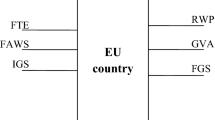Abstract
The contradiction between ecological maintenance and economic production is increasingly prominent with the rapid development of forestry. Uncovering the forestry eco-efficiency which integrates ecology, resources and economic production is the premise of mitigating the hazards of strict reliance on heavy inputs and improving the resource utilization efficiency in forestry. This paper applies a three-stage data envelopment analysis (DEA) model combined with the DEA-Malmquist approach to eliminate the interferences of external environment and random errors and reveal the evolution of real forestry eco-efficiency and its decomposition. Besides, it is beneficial to understand the convergence of forestry eco-efficiency for grasping the long-term efficient operation mechanism of ecological production. The empirical results demonstrate that the forestry eco-efficiency progress is closely related to an excellent environment and efficient internal management by comparing the results between stage I and stage III. Different environmental variables have different effects on the slack of different inputs in stage II. Moreover, the convergence analysis proves the existence of absolute convergence and conditional convergence of forestry eco-efficiency in the whole China and six regions; that is, the catch-up effect is observed in backward provinces. Hence, targeted policy suggestions are provided to achieve forestry return to its green essence.







Similar content being viewed by others
Data and material availability
Available.
Code availability
Available.
Change history
14 September 2023
A Correction to this paper has been published: https://doi.org/10.1007/s10342-023-01602-8
Notes
Chinese government carried out forestation policies to increase forestry reserves, including Natural Forest Protection Project, Green for Grain Project, Beijing-Tianjin Sandstorm Source Control Project and so on.
References
Aigner D, Lovell CK, Schmidt P (1977) Formulation and estimation of stochastic frontier production function models. J Econo 6(1):21–37. https://doi.org/10.1016/0304-4076(77)90052-5
Banker RD, Charnes A, Cooper WW (1984) Some models for estimating technical and scale inefficiencies in data envelopment analysis. Manag Sci 30(9):1078–1092. https://doi.org/10.1287/mnsc.30.9.1078
Bernard A, Jones C (2001) Comparing apples to oranges: productivity convergence and measurement across industries and countries. Am Econ Rev 86(5):1216–1238
Cao L, Zhou Z, Wu Y, Huang Y, Cao G (2019) Is metabolism in all regions of China performing well?–Evidence from a new DEA-Malmquist productivity approach. Ecol Ind 106:105487. https://doi.org/10.1016/j.ecolind.2019.105487
Castilho D, Fuinhas JA, Marques AC (2021) The impacts of the tourism sector on the eco-efficiency of the Latin American and Caribbean countries. Socioecon Plann Sci 78:101089. https://doi.org/10.1016/j.seps.2021.101089
Charnes A, Cooper WW, Rhodes E (1978) Measuring the efficiency of decision making units. Eur J Oper Res 2(6):429–444. https://doi.org/10.1016/0377-2217(78)90138-8
Chen Y, Liu L (2022) Improving eco-efficiency in coal mining area for sustainability development: An emergy and super-efficiency SBM-DEA with undesirable output. J Clean Prod 339:130701. https://doi.org/10.1016/j.jclepro.2022.130701
Chen J, Wu Y, Song M, Zhu Z (2017) Stochastic frontier analysis of productive efficiency in China’s forestry industry. J Econ 28:87–95. https://doi.org/10.1016/j.jfe.2017.05.005
Chen N, Qin F, Zhai Y, Cao H, Zhang R, Cao F (2020) Evaluation of coordinated development of forestry management efficiency and forest ecological security: a spatiotemporal empirical study based on China’s provinces. J Clean Prod 260:121042. https://doi.org/10.1016/j.jclepro.2020.121042
Chen Y, Miao J, Zhu Z (2021) Measuring green total factor productivity of China’s agricultural sector: a three-stage SBM-DEA model with non-point source pollution and CO2 emissions. J Clean Prod 318:128543. https://doi.org/10.1016/j.jclepro.2021.128543
Färe R, Grosskopf S, Lindgren B, Roos P (1992) Productivity changes in Swedish Pharamacies 1980–1989: a non-parametric malmquist approach. J Prod Anal 3:85–101. https://doi.org/10.1007/BF00158770
Färe R, Grosskopf S, Norris M, Zhang Z (1994) Productivity growth, technical progress and efficiency changes in industrialized countries. Am Econ Rev 84:66–83
Feng M, Li X (2020) Evaluating the efficiency of industrial environmental regulation in China: a three-stage data envelopment analysis approach. J Clean Prod 242:118535. https://doi.org/10.1016/j.jclepro.2019.118535
Fried HO, Lovell CAK, Schmidt SS, Yaisawarng S (2002) Accounting for environmental effects and statistical noise in data envelopment analysis. J Prod Anal 17(1–2):157–174. https://doi.org/10.1023/A:1013548723393
Gong B (2020) Agricultural productivity convergence in China. China Econ Rev 60:101423. https://doi.org/10.1016/j.chieco.2020.101423
Holod D, Lewis HF (2011) Resolving the deposit dilemma: a new DEA bank efficiency model. J Bank Finance 35(11):2801–2810. https://doi.org/10.1016/j.jbankfin.2011.03.007
Jondrow J, Lovell CAK, Materov IS, Schmidt P (1982) On the estimation of technical inefficiency in the stochastic frontier production function model. J Econ 19(2–3):233–238. https://doi.org/10.1016/0304-4076(82)90004-5
Ke S, Qiao D, Zhang X, Feng Q (2021) Changes of China’s forestry and forest products industry over the past 40 years and challenges lying ahead. Forest Policy Econ 106:101949. https://doi.org/10.1016/j.forpol.2020.102352
Li L, Hao T, Chi T (2017) Evaluation on China’s forestry resources efficiency based on big data. J Clean Prod 142:513–523. https://doi.org/10.1016/j.jclepro.2016.02.078
Lin B, Ge J (2019) Carbon sinks and output of China’s forestry sector: an ecological economic development perspective. Sci Total Environ 655:1169–1180. https://doi.org/10.1016/j.scitotenv.2018.11.219
Lin Y, Chen W, Liu J (2021) Research on the temporal and spatial distribution and influencing factors of forestry output efficiency in China. Sustainability 13(9):4687. https://doi.org/10.3390/su13094687
Liu Y, Dong F (2021) How technological innovation impacts urban green economy efficiency in emerging economies: a case study of 278 Chinese cities. Resour Conserv Recycl 169:105534. https://doi.org/10.1016/j.resconrec.2021.105534
Liu Z, Zhang H, Zhang YJ, Zhu TT (2020) How does industrial policy affect the eco-efficiency of industrial sector? Evidence from China. Appl Energy 272:115206. https://doi.org/10.1016/j.apenergy.2020.115206
Lu L, Zhang J, Yang F, Zhang Y (2020) Evaluation and prediction on total factor productivity of Chinese petroleum companies via three-stage DEA model and time series neural network model. Sustain Comput: Inf Syst 27:100397. https://doi.org/10.1016/j.suscom.2020.100397
Mirmozaffari M, Yazdani M, Boskabadi A, Dolatsara HA, Kabirifar K, Golilarz NA (2020) A novel machine learning approach combined with optimization models for eco-efficiency evaluation. Appl Sci 10(15):5210. https://doi.org/10.3390/app10155210
Mirmozaffari M, Shadkam E, Khalili SM, Kabirifar K, Yazdani R, Asgari Gashteroodkhani T (2021a) A novel artificial intelligent approach: comparison of machine learning tools and algorithms based on optimization DEA Malmquist productivity index for eco-efficiency evaluation. Int J Energy Sect Manag 15(3):523–550. https://doi.org/10.1108/IJESM-02-2020-0003
Mirmozaffari M, Yazdani R, Shadkam E, Tavassoli LS, Massah R (2021b) VCS and CVS: new combined parametric and non-parametric operation research models. Sustain Op Comput 2:36–56. https://doi.org/10.1016/j.susoc.2021.03.002
Mirmozaffari M, Yazdani R, Shadkam E, Khalili SM (2022) A novel hybrid parametric and non-parametric optimisation model for average technical efficiency assessment in public hospitals during and post-COVID-19 pandemic. Bioengineering 9(1):7. https://doi.org/10.3390/bioengineering9010007
Młynarski W, Prędki A, Kaliszewski A (2021) Efficiency and factors influencing it in forest districts in southern Poland: application of data envelopment analysis. Forest Policy Econ 130:102530. https://doi.org/10.1016/j.forpol.2021.102530
Ning Y, Liu Z, Ning Z, Zhang H (2018) Measuring eco-efficiency of state-owned forestry enterprises in northeast China. Forests 9(8):455. https://doi.org/10.3390/f9080455
Rosano-Peña C, Pensado-Leglise MDR, Marques Serrano AL, Bernal-Campos AA, Hernández-Cayetano M (2022) Agricultural eco-efficiency and climate determinants: application of dea with bootstrap methods in the tropical montane cloud forests of Puebla Mexico. Sustain Environ 8(1):1–14. https://doi.org/10.1080/27658511.2022.2138852
Shang H, Jiang L, Pan X, Pan X (2022) Green technology innovation spillover effect and urban eco-efficiency convergence: evidence from Chinese cities. Energy Econ 114:106307. https://doi.org/10.1016/j.eneco.2022.106307
Shephard RW (1953) Cost and production functions. Princeton University Press, Princeton
Song M, Ma X, Shang Y, Zhao X (2020) Influences of land resource assets on economic growth and fluctuation in China. Resour Policy 68:101779. https://doi.org/10.1016/j.resourpol.2020.101779
Stergiou E, Kounetas KE (2021) Eco-efficiency convergence and technology spillovers of European industries. J Environ Manag 283:111972. https://doi.org/10.1016/j.jenvman.2021.111972
Su L, Ji X (2021) Spatial-temporal differences and evolution of eco-efficiency in China’s forest park. Urban For Urban Green 57:126894. https://doi.org/10.1016/j.ufug.2020.126894
Tang M, Li Z, Hu F, Wu B (2020) How does land urbanization promote urban eco-efficiency? The mediating effect of industrial structure advancement. J Clean Prod 272:122798. https://doi.org/10.1016/j.jclepro.2020.122798
Vásquez-Ibarra L, Rebolledo-Leiva R, Angulo-Meza L, González-Araya MC, Iriarte A (2020) The joint use of life cycle assessment and data envelopment analysis methodologies for eco-efficiency assessment: a critical review, taxonomy and future research. Sci Total Environ 738:139538. https://doi.org/10.1016/j.scitotenv.2020.139538
Wang C, Jiang Q, Engel B, Mercado JAV, Zhang Z (2020) Analysis on net primary productivity change of forests and its multi–level driving mechanism—a case study in Changbai Mountains in Northeast China. Technol Forecast Soc Chang 153:119939. https://doi.org/10.1016/j.techfore.2020.119939
Wu L, Zhang Z (2020) Impact and threshold effect of Internet technology upgrade on forestry green total factor productivity: evidence from China. J Clean Prod 271:122657. https://doi.org/10.1016/j.jclepro.2020.122657
Xiong L, Wang F, Cheng B, Yu C (2018) Identifying factors influencing the forestry production efficiency in Northwest China. Resour Conserv Recycl 130:12–19. https://doi.org/10.1016/j.resconrec.2017.11.009
Yang H, Yuan T, Zhang X, Li S (2016) A decade trend of total factor productivity of key state-owned forestry enterprises in China. Forests 7(5):97. https://doi.org/10.3390/f7050097
Zeng L (2021) China’s eco-fficiency: regional differences and influencing factors based on a spatial panel data approach. Sustainability 13(6):3143. https://doi.org/10.3390/su13063143
Zeng J, Han J, Qu J, Maraseni TN, Xu L, Li H, Liu L (2021) Ecoefficiency of China’s agricultural sector: what are the spatiotemporal characteristics and how are they determined? J Clean Prod 325:129346. https://doi.org/10.1016/j.jclepro.2021.129346
Zhang X, Xu D (2022) Assessing the eco-efficiency of complex forestry enterprises using LCA/time-series DEA methodology. Ecol Ind 142:109166. https://doi.org/10.1016/j.ecolind.2022.109166
Zhong S, Wang H (2021) The effect of total factor productivity of forestry industry on CO2 emissions: a spatial econometric analysis of China. Sci Rep 11(1):1–21. https://doi.org/10.1038/s41598-021-93770-z
Zhuo C, Deng F (2020) How does China’s Western development strategy affect regional green economic efficiency? Sci Total Environ 707:135939. https://doi.org/10.1016/j.scitotenv.2019.135939
Acknowledgements
This work was supported by National Natural Science Foundation of China (No.72174180, No.71673250); Major Projects of the Key Research Base of Humanities Under the Ministry of Education (No.22JJD790080); Zhejiang Provincial Natural Science Foundation for Distinguished Young Scholars (No.LR18G030001); and Zhejiang Provincial Philosophy and Social Science Planning Project (No.22QNYC13ZD, No.21NDYD097Z).
Author information
Authors and Affiliations
Contributions
Yufeng Chen involved in conceptualization; methodology; funding acquisition; and writing—reviewing and editing. Lihua Ma involved in formal analysis; methodology; data curation; and software. Jiafeng Miao involved in data curation; writing—original draft preparation; visualization; and writing—reviewing and editing. Xiaoxiong Hui involved in formal analysis and methodology.
Corresponding author
Ethics declarations
Conflict of interest
The authors declare that they have no known competing financial interests or personal relationships that could have appeared to influence the work reported in this paper.
Additional information
Communicated by Matthias Bösch.
Publisher's Note
Springer Nature remains neutral with regard to jurisdictional claims in published maps and institutional affiliations.
The original online version of this article was revised due to the errors in Tables 5 and 6. The Tables 5 and 6 have been corrected.
Rights and permissions
Springer Nature or its licensor (e.g. a society or other partner) holds exclusive rights to this article under a publishing agreement with the author(s) or other rightsholder(s); author self-archiving of the accepted manuscript version of this article is solely governed by the terms of such publishing agreement and applicable law.
About this article
Cite this article
Chen, Y., Ma, L., Miao, J. et al. Does Chinese forestry eco-efficiency converge? A three-stage DEA-Malmquist approach. Eur J Forest Res 142, 1259–1277 (2023). https://doi.org/10.1007/s10342-023-01573-w
Received:
Revised:
Accepted:
Published:
Issue Date:
DOI: https://doi.org/10.1007/s10342-023-01573-w




